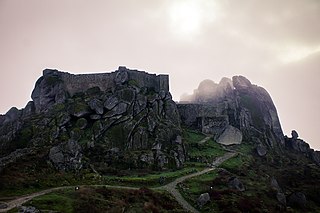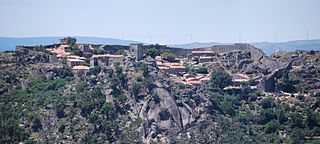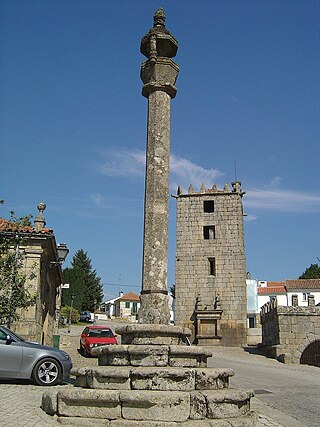
Castle of Braga is a historical fortification and defensive line encircling the city of Braga. While, in fact, the only remains of this structure are the various gates and towers along its perimeter, the main keep tower, located in the civil parish of São João do Souto, is the only true remnant of the medieval castle.

The Castle of Elvas is a medieval military fortification in Portugal, in the civil parish of Alcáçova, municipality of Elvas, part of a first line of defense in the Portuguese Alentejo, in conjunction with the military forts of Ouguela, Campo Maior, Olivença and Juromenha.

The Castle of Beja is a medieval castle in the civil parish of Beja, municipality of Beja, Portuguese district of Beja.

The Castle of Castelo Branco, is a Portuguese medieval castle in civil parish of Castelo Branco, in the municipality of the same name, in the Centro district of Castelo Branco. Known locally, as the Castelo dos Templários, the Romanesque castle was constructed under the orders of King Afonso II of Portugal in 1214.

The Castle of Monsanto is a medieval castle located in the civil parish of Monsanto e Idanha-a-Velha, in the municipality of Idanha-a-Nova, Portuguese district of Castelo Branco.

The Castle of Moreira de Rei is a well-preserved medieval castle located in the civil parish of Moreira de Rei, in the municipality of Trancoso, Portuguese district of Guarda.

The Castle of Redondo is a medieval castle located in the civil parish of Redondo, in the municipality of Redondo, Portuguese Évora.

The Castle of Sortelha (Portuguese: Castelo de Sortelha is a castle in the civil parish of Sortelha in the municipality of Sabugal in the Portuguese Centro region, classified as a National Monument.

The Castle of Folgosinho, is a medieval castle in the civil parish of Folgosinho, municipality of the Gouveia in the district of Guarda in the Centre region of Portugal.

The Castle of Pombal, is a medieval castle in the civil parish of Pombal, municipality of the same name in the district of Leiria in the Centre region of Portugal.

The Castle of Vilar Maior is a well-preserved medieval castle located in the civil parish of Aldeia da Ribeira, Vilar Maior e Badamalos, in the municipality of Sabugal, Guarda district, Portugal.

The Pillory of Aguiar da Beira is a pillory located in the civil parish of Aguiar da Beira e Coruche, in the municipality of Aguiar da Beira, Portuguese district of Guarda.

The Castle of Penedono is a medieval castle located in the civil parish of Penedono e Granja, in the municipality of Penedono, Portuguese district of Viseu.

The Castle of Óbidos is a well-preserved medieval castle located in the civil parish of Santa Maria, São Pedro e Sobral da Lagoa, in the municipality of Óbidos, Portuguese District of Leiria.

The Castle of Santo Estêvão is a medieval castle located in the civil parish of Santo Estêvão, municipality of Chaves, in the Portuguese district of Vila Real. Located in a dominant position over the village, the castle is within walking distance of the course of the river Tamega and the border with Spain.

The Castle of Castelo Bom, is a medieval castle in the civil parish of Castelo Bom, municipality of the Almeida in the district of Guarda in the Centre region of Portugal.

The Castle of Ródão is a medieval castle located in the civil parish of Vila Velha de Ródão, in the municipality of Vila Velha de Ródão, Portuguese Castelo Branco.
The Castle of Vila Nova de Foz Côa is a medieval castle located in the civil parish of Vila Nova de Foz Côa, in the municipality of Vila Nova de Foz Côa, Portuguese Guarda.

The Castle of Penamacor is a medieval castle located in the civil parish of Penamacor, in the municipality of Penamacor, Portuguese district of Castelo Branco.



















